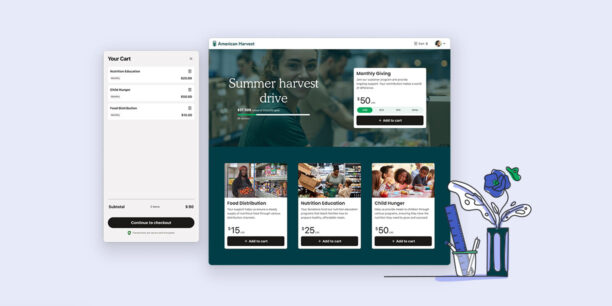Quick Tips for Peer-to-Peer Fundraisers to Get Started

Request a Demo
Learn how top nonprofits use Classy to power their fundraising.
When you empower your supporters to peer-to-peer fundraise on your nonprofit’s behalf, you can increase your revenue raised and people reached exponentially. The key to a successful peer-to-peer fundraising campaign, however, is to empower your fundraisers with the tools and tips they need to effectively evangelize your cause and solicit their networks for donations.
Free Download: The Anatomy of a Successful Peer-to-Peer Fundraising Campaign
Below is a list of fundraising tips and best practices to send to your individual fundraisers. Pass this along to your community so they can get the ball rolling and see the progress bars on their individual fundraising pages climb.
Do These 3 Things After Creating a Personal Fundraising Page
Start by making a donation to your own fundraising page. Other people are more likely to donate to your page when they see that someone has already contributed. Donating some of your own money also demonstrates to potential supporters that you are serious about helping the cause.
Personalize your fundraising page by adding your own text, pictures, or video. Remember, your potential donors will be interested in the cause, but they are primarily interested in you. Make sure you tell them why you are getting involved and what your connection to the cause is (it doesn’t have to be long).
Send individual emails to your five closest contacts and ask them for donations first. Getting your “inner circle” to donate to your page will help you build up some momentum.
Download Your Fundraising Campaign Checklists
The Best Way to Reach Out to Friends and Family
Think about your fundraising strategy like peeling an onion from the inside out. The best fundraisers start by asking their closest contacts first (the core), and progressively working outward to more distant contacts (the outer skin).
After all, your “core” group includes the people most likely to donate to your personal fundraising page. Studies show that as you make progress towards your fundraising goal, people become more and more likely to donate. When you start with your closest contacts and work outwards, you ensure that you build up progress from your core supporters before you reach out to the people who are less likely to donate. This means you can maximize your chances of ultimately reaching (or exceeding) your fundraising goal.
Understand the True Financial Potential of Peer-to-Peer Fundraising
Action Items to Get Started
Take these steps to get the ball rolling on your campaign:
- Day 1, email #1: Send to 10 very close contacts (family and your closest friend or two)
- Day 2, email #2: Send to 10 to 50 close contacts (your entire circle of good friends)
- Day 3, email #3: Send to as many other contacts that you feel comfortable sending a message to (coworkers, friends of friends, distant relatives, your entire address book, etc.)
- Day 4, social media and beyond: promote across your social media channels
Don’t be afraid to send follow-up emails. Your close friends and family won’t mind hearing from you a few times.
How to Write Your Emails to Friends and Family
There is no perfect formula for writing an email asking family and friends for donations, but here are some best practices to guide you.
Writing a General Email
- Start by explaining your connection to the cause and why it’s important to you. Describing how the cause has touched your life is probably the most important element of your message.
- Explain, in a sentence or two, the good work the organization is doing to advance the cause. This helps potential supporters understand where their money would be going and what it would be used to accomplish.
- Be clear to potential supporters about what you are looking for; make a direct ask for financial support.
- Include a link to your personal fundraising page.
- Thank your contacts for their time and support.
Writing to Your Closest Contacts
- You know your closest contacts better than anyone does. Don’t feel like you have to stick to a predefined formula
- If a one line message is going to work, go ahead and do that. If a longer personal message will work best, do that.
- Just make sure you include a direct request for support and a link to your fundraising page at the end of your message
Always remember that when you’re writing to your contacts, just be yourself. If something feels forced or inauthentic, scrap it.
Use Facebook to Fundraise
Start fundraising through Facebook and after you’ve sent out your initial batch of emails. If the organization you’re supporting is on Classy, note that the Classy for Facebook integration allows fundraisers to duplicate their Classy fundraising page to Facebook in just a few clicks.
Learn How Classy for Facebook Can Help Improve Your Fundraiser Retention
After creating a personal peer-to-peer or registration with fundraising campaign page, a fundraiser can easily push that campaign, complete with their name, photo, and personal headline, to Facebook to create a Facebook fundraiser. Your fundraising progress will sync across both your Classy campaign and your Facebook fundraiser.
Once you take advantage of this, follow these tips to solicit your Facebook network:
- Tag and thank the people who have already donated to you. Not only can this increase exposure across both your profiles, but this also sets the stage to the rest of your followers that people are already donating to your page.
- Set internal goals (e.g. $200 by the end of week two, $400 by end of week four, etc.). Use your social media accounts to give updates of your progress towards each goal and ask for people to help you get over the next hurdle.
- Don’t make every post an “ask.” Share inspiring news stories or other positive anecdotes about the cause too.
- Consider offering your own gifts to friends and family who help you reach your goal. It doesn’t have to be anything extravagant, just a token of your appreciation.
Follow Up With People Who Don’t Initially Respond
Setting internal goals for how much you want to raise, by when, helps you accomplish two things. First, you create more urgency when you ask friends and family for support. Second, you give yourself a reason to follow up.
- Reach back out to non-responders when you’re approaching one of your internal goals. If you set a few internal goals, you can plan on sending a couple follow-up emails. Remember, people can easily miss or skip over your initial outreach.
- Include progress updates in your follow-up messages, and consider including any inspiring stories or personal anecdotes you have about the cause.
- Remember to continue using social media. Social media is a softer medium for communicating with your contacts, and it’s more acceptable to frequently post updates in those channels.
Tips to Run a Peer-to-Peer Fundraising Team
Fundraising teams help foster friendly competition and group morale in order to raise money for good. Here are some starting tips if you’re interested in starting a team for a nonprofit’s peer-to-peer campaign:
- After you create your team fundraising page, you need to recruit your team members. Start by emailing or calling the people you think might be interested in joining you, and follow that up by making a few requests through Facebook and Twitter.
- As people join your team, send them a quick email to thank them for joining and helping the cause.
- Set a reasonable team fundraising goal, and send an email out to the group thanking them again and communicating the team goal.
- Send periodic updates about the team’s progress (this prevents slacking and keeps everyone committed) and encourage people to share the fundraising tips, tactics, and ideas that are successful for them.
- Be supportive and send along words of encouragement to team members as you work together towards the goal.
Peer-to-peer fundraising success comes with your passion for the cause, commitment to follow through, and dose of individual creativity. Your efforts are directly impacting an organization’s ability to continue their meaningful work, so keep it up and see your fundraising progress climb.

Checklists for Crowdfunding, Peer-to-Peer, and Event Fundraising Campaigns
Subscribe to the Classy Blog
Get the latest fundraising tips, trends, and ideas in your inbox.
Thank you for subscribing
You signed up for emails from Classy
Request a Demo
Learn how top nonprofits use Classy to power their fundraising.
 Explore Classy.org
Explore Classy.org 

